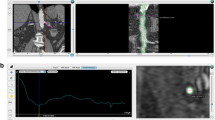Abstract
Fibromuscular dysplasia (FMD) is one of the most common causes of renovascular hypertension in children and women. It is characterized by short multiple stenoses alternated to focal expansions that usually involve the lateral third of the renal artery. Digital subtraction angiography is considered the most accurate method in the diagnosis of renal artery FMD. An indirect sign of FMD—the notches on the ureter secondary to the hypertrophy of the branches of ureteric arteries “climbing” along the ureters—can be visualised during urography. We report the case of a 38-years-old woman with hypertension and no history of familiar predisposition, in which the multidetector computed tomography angiography was able to show both direct and indirect radiological signs of renal artery FMD. 2D and 3D visualisations are useful to suggest the diagnosis of FMD and in the follow-up in patients who underwent to percutaneous transluminal angioplasty.




Similar content being viewed by others
References
Anderson CA, Hansen KJ, Benjamin ME, Keith DR, Craven TE, Dean RH (1995) Renal artery fibromuscular dysplasia: results of current surgical therapy. J Vasc Surg 22:207–216
Beregi JP, Elkohen M, Deklunder G, Artaud D, Coullet JM, Wattinne L (1996) Helical CT angiography compared with arteriography in the detection of renal artery stenosis. AJR Am J Roentgenol 167:495–501
Chait A, Matasar KW, Fabian CE, Mellins HZ (1971) Vascular impressions on the ureters. Am J Roentgenol Radium Ther Nucl Med 111:729–749
Chobanian AV, Bakris GL, Black HR, Cushman WC, Green LA, Izzo JL Jr, Jones DW, Materson BJ, Oparil S, Wright JT Jr, Roccella EJ, Joint National Committee on Prevention, Detection, Evaluation, Treatment of High Blood Pressure. National Heart, Lung, Blood Institute; National High Blood Pressure Education Program Coordinating Committee (2003) Seventh report of the Joint National Committee on prevention, detection, evaluation, and treatment of high blood pressure. Hypertension 42:1206–1252
Cragg AH, Smith TP, Thompson BH, Maroney TP, Stanson AW, Shaw GT, Hunter DW, Cochran ST (1989) Incidental fibromuscular dysplasia in potential renal donors: long-term clinical follow-up. Radiology 172:145–147
Daniel O, Shackman R (1952) Blood supply of human ureter in relation to ureterocolic anastomosis. Br J Urol 24:334–343
Das CJ, Neyaz Z, Thapa P, Sharma S, Vashist S (2007) Fibromuscular dysplasia of the renal arteries: a radiological review. Int Urol Nephrol 39:233–238
De Fraissinette B, Garcier JM, Dieu V, Mofid R, Ravel A, Boire JY, Boyer L (2003) Percutaneous transluminal angioplasty of dysplastic stenoses of the renal artery: results on 70 adults. Cardiovasc Intervent Radiol 26:46–51
Dyer RB, Chen MY, Zagoria RJ (2004) Classic signs in uroradiology. Radographics 24:S242–S280
Hagg A, Aberg H, Eriksson I, Lorelius LE, Morlin C (1987) Fibromuscular dysplasia of the renal artery—management and outcome. Acta Chir Scand 53:15–20
Lassiter FD (1998) The string-of-beads sign. Radiology 206:437–438
Novick AC, Ziegelbaum M, Vidt DG, Gifford RW Jr, Pohl MA, Goormastic M (1987) Trends in surgical revascularization for renal artery disease: ten years’ experience. JAMA 257:498–501
Paven G, Waugh R, Nicholson J, Gillin A, Hennessy A (2006) Screening tests for renal artery stenosis: a case-series from an Australian tertiary referral centre. Nephrology (Carlton) 11:68–72
Pennington N, Soames RW (2005) The anterior visceral branches of the abdominal aorta and their relationship to the renal arteries. Surg Radiol Anat 27:395–403
Petru B, Elena S, Dan I, Constantin D (2007) The morphology and the surgical importance of the gonadal arteries originating from the renal artery. Surg Radiol Anat 29:367–371
Pickering TG (1989) Renovascular hypertension: etiology and pathophysiology. Semin Nucl Med 19:79–88
Reiher L, Pfeiffer T, Sandmann W (2000) Longterm results after surgical reconstruction for renal artery fibromuscular dysplasia. Eur J Vasc Endovasc Surg 20:556–559
Riederer SJ, Bernstein MA, Breen JF, Busse RF, Ehman RL, Fain SB, Hulshizer TC, Iii JH, King BF, Kruger DG, Rossman PJ, Shah S (2000) Three-dimensional contrast-enhanced MR angiography with real-time fluoroscopic triggering: design specifications and technical reliability in 330 patient studies. Radiology 215:584–593
Sabharwal R, Vladica P, Coleman P (2007) Multidetector spiral CT renal angiography in the diagnosis of renal artery fibromuscular dysplasia. Eur J Radiol 61:520–527
Slovut DP, Olin JW (2004) Fibromuscular dysplasia. N Engl J Med 350:1862–1871
Standring S, Ellis H, Healy J, Johnson D, Williams A (2005) Gray’s Anatomy, 39th edn. Churchill Livingstone, London, p 555
Willoteaux S, Faivre-Pierret M, Moranne O, Lions C, Bruzzi J, Finot M, Gaxotte V, Mounier-Vehier C, Beregi JP (2006) Fibromuscular dysplasia of the main renal arteries: comparison of contrast-enhanced MR angiography with digital subtraction angiography. Radiology 241:922–999
Author information
Authors and Affiliations
Corresponding author
Rights and permissions
About this article
Cite this article
Clemente, A., Macchi, V., Porzionato, A. et al. CTA and 2D–3D post-processing: radiological signs of fibromuscular dysplasia of renal artery. Surg Radiol Anat 31, 25–29 (2009). https://doi.org/10.1007/s00276-008-0384-8
Received:
Accepted:
Published:
Issue Date:
DOI: https://doi.org/10.1007/s00276-008-0384-8




